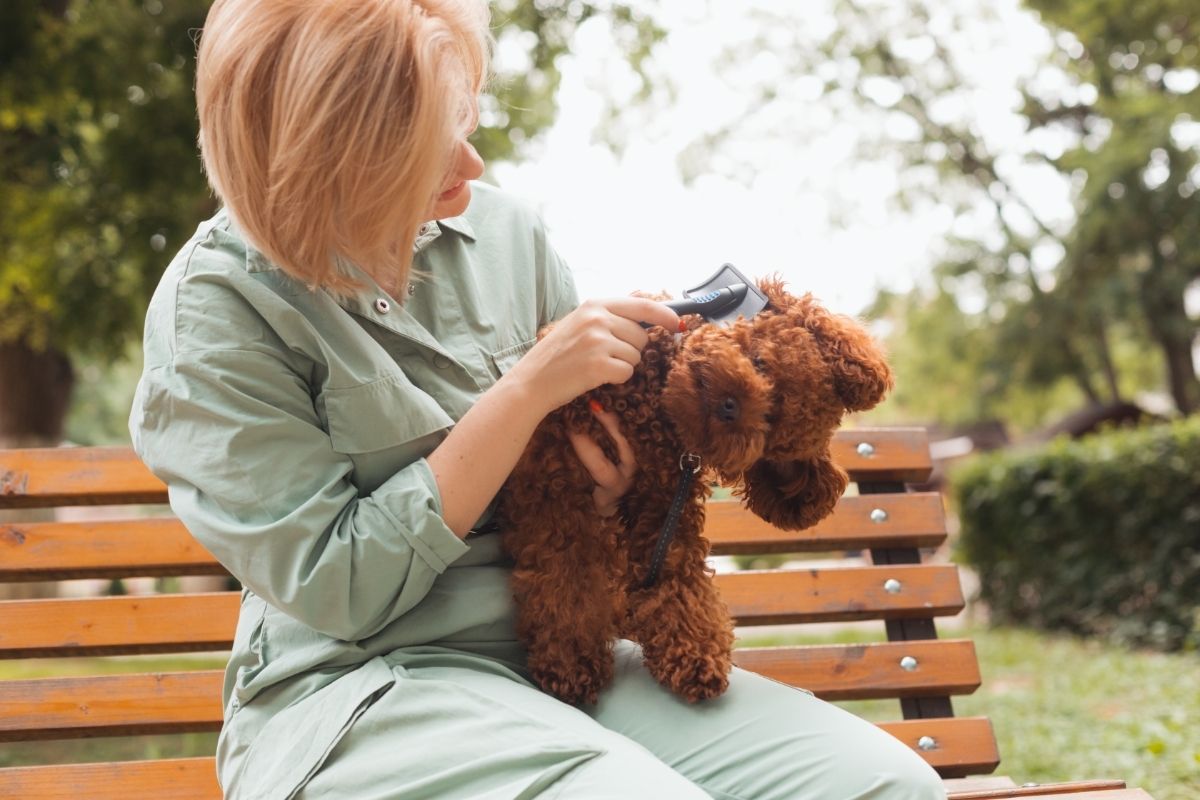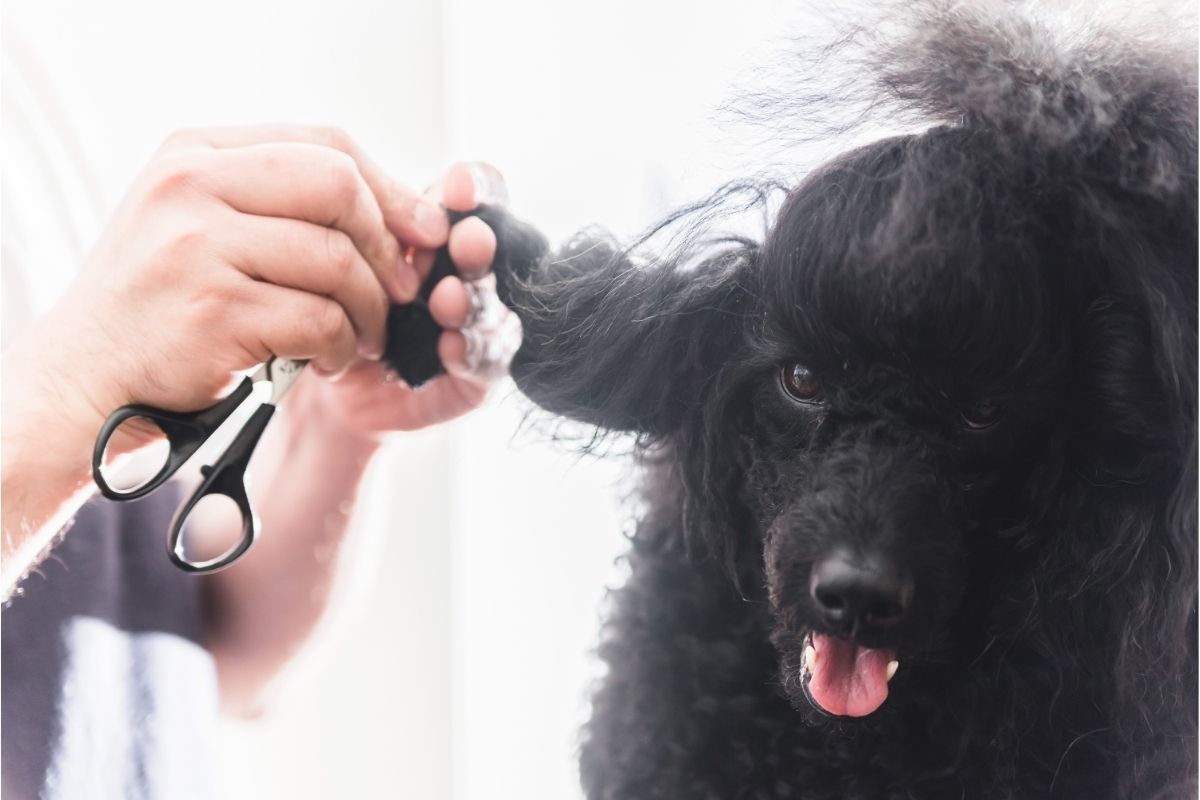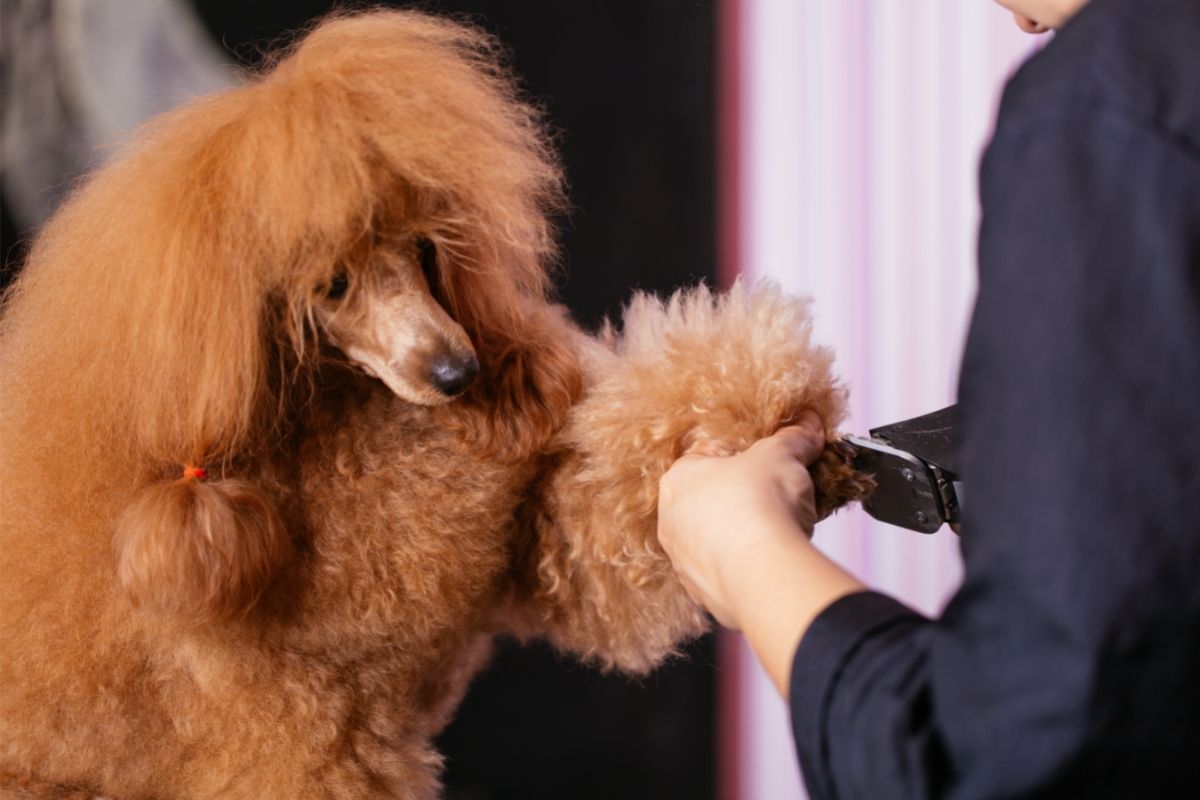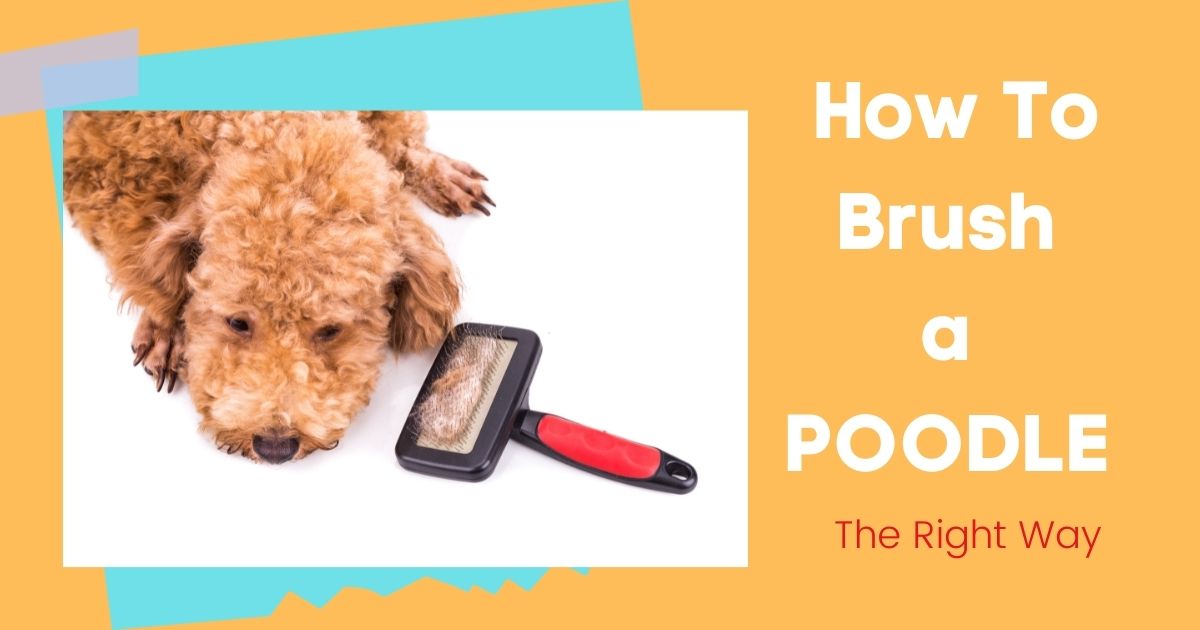The Technique of Poodle Line Brushing
Whether you’ve already got a poodle at home or are considering getting one, a question you may be asking yourself could be: How to brush a poodle?
With their long and extremely curly fur, brushing a poodle may seem like a daunting task to many owners or owners to be. Luckily, it does not have to be that difficult. One of the techniques you can use is line brushing. A technique used to make sure you get all the tangles out, one line at a time! But, what is line brushing? Keep reading to find out!

Step-by-Step Poodle Brushing Instructions
The idea of line brushing is to simply brush your poodle’s curly fur and hair, one line at a time. However, to make the line brushing easier for yourself, you should do a few steps first and always be systematic.
Being systematic will let your poodle know what to expect. Therefore, knowing what to expect should ensure that your poodle is more comfortable with the whole process.
Step 1: Getting Everything Ready
Whether your dog loves some pampering or is more reluctant, getting everything prepared before getting your dog will alleviate some stress your dog may otherwise experience. Place all brushes, sprays, and treats within easy reach- but far enough that your dog won’t see the treats as a buffet!
We recommend that you get a grooming table for your poodle to make sure it has a raised and steady surface to stand on, which will make your job a lot easier and better for your back. Any steady, sturdy, and secure surface, like the floor, should work just fine!
When all your tools are ready, it is time to get your poodle up onto the table- or down on the floor with it, whichever you prefer.
Step 2: Conditioning
It is your choice to use a conditioner or not. However, we highly recommend that you do!
Using a leave-in conditioner or hair treatment will help you detangle the curls and make the whole experience more comfortable for your poodle, as you won’t need to use as much strength to brush through your poodle’s fur.
Besides detangling, the conditioner will also help rehydrate the hair and minimize static hair.
The best conditioner for any dog will be a conditioner without perfume and excessive additives. If your dog has any health conditions or other issues regarding its fur, you can always consult your veterinarian on the best option for your unique dog.
Step 3: The First Brushing
You should give your dog a light brushing all over. Some owners prefer to use a pin brush for this stuff; others prefer a slicker brush. It comes down to your preference.
In this step, you do not need to get all the way down to the skin when brushing. Instead, it is just to assess whether the hair is tangled or matted while getting the fur ready for the more in-depth brushing.
Step 4: Line Brushing
Now it is time for the in-depth line brushing. Here you can also use a slicker brush or a pin brush. I use either my pin brush or my protected slicker brush. The protected slicker brush is a slicker brush where the pins are protected with small rubber dots on the ends- to prevent scratching the skin. Again, any of the types will do.
When line brushing, you should be systematic, starting at either end of your dog and moving downwards.
Wherever you start, you must do the following:
- Form a part in the fur- take small sections at a time.
- Lay the fur back away from the area you want to brush.
- Brush through the first small section until it is tangle-free.
- Form a new part and brush that section.
- Continue with this all the way through the entire dog’s coat.
Take special care to brush the friction-rich areas like the armpits and groin area.
Line brushing can seem like quite an extensive process, but by being systematic and getting your dog used to the process, you will be through it in no time!
What Should I Do When I Find a Matt in My Poodle’s Hair?
When going through step 3, you should always look for tangles and matting. If you come across a matt, you can gently attempt to loosen it with a brush. However, if it seems thoroughly matted and stuck, do not attempt to rip it out – it will only be painful to your dog.
Instead of struggling with the mat, you can opt to cut the worst of the matt off with a pair of scissors. Hereafter, you can brush through the rest of it. Cutting it off may result in uneven fur, though, which may be unwanted in very long-haired poodles and ones preparing for the show ring.
Another option is to use a dematting tool. Dematting tools have sharp blades that can cut through the mat without pulling excessively on your dog’s skin. Gently work the dematting tool through the matt and towards the skin. When the matt is loosened, brush carefully through it with a pin brush.

The Benefits of Brushing Your Poodle Regularly
You’ll hear many people say that poodles don’t shed. Unfortunately, that’s not strictly true. Just like humans, a poodle’s hair will bend and break- effectively shedding some of their hair. However, the hair will then get stuck within the tight curls instead of landing on your favorite white couch, giving the impression that the dog doesn’t shed.
The unique way a poodle shed is one of the reasons why it is so important to brush your poodle regularly. If not brushed frequently, the tight curls and broken hair, as well as dirt and debris, will clamp together and form tight hairy mats.
Matted and tangled hair can be painful for your dog, and it can also lead to an increased risk of some skin diseases. If the mats get too big, they may even limit your dog’s movements!
How often you need to brush your poodle will depend on the length of the hair, the weather, and your preferred lifestyle, amongst other things.
It goes without saying that if you have a long-haired poodle with a show-cut, it will need far more frequent brushing than a short-haired poodle with a sports cut. But, in the end, it is all about avoiding matting and tangling.
My reasonably short-haired poodle is brushed once every other week or so. Unless he’s been running through the forest, then he will need to have the dirt brushed out of the fur more frequently!
A long-haired poodle should be brushed thoroughly once a week as a general rule of thumb.
What to do When Your Poodle Hates Brushing
If you look up videos of line brushing as well as other types of brushing and grooming, you will often find them to be very relaxed, perhaps even sleeping, poodles. That is not always the reality. We know that!
Getting your dog to enjoy brushing takes lots of training, treats, and patience, but even then, not all poodles will grow to love grooming. My poodle will stand still and accept it and looks at me like I might attempt to chop his paw off next.
To help your dog come to enjoy the grooming session more, you should grab some things:
- Chew toys
- Treats
- Leave-in conditioner
- Soft brushes
Chew Toys
Chew toys are there to help distract your poodle. Please don’t turn the grooming session into a direct play session, especially not on the table, but make it fun. If your poodle prefers chewing on a rubber duck while you’re brushing, then go for it!
Treats
Chew toys and treats may also both be used as rewards. I recommend that the treats are used during the brushing, and the toys are reserved for after. How much you should use the treats depends on how much your poodle hates being brushed.
Fear of the Brush
If your dog covers as soon as it sees the brush, that is where you will start. Take the brush out and reward your dog for not running. If your dog is scared of being touched by the brush, you will need to start rewarding whenever you touch your dog- don’t brush yet! Just reward the touching.
Fear of Brushing
If your dog is alright with being touched and being on the table or the floor but just hates the brushing part, you can also use the treats. Very gently brush your dog, maybe just one minor stroke and reward. Slowly build your way towards proper strokes and brushing in tiny steps.
Dislike of Brushing
Dislike and fear are two very different things for dogs, and it is imperative that you know the difference. If you are in any way in doubt whether your dog is scared or just not fond of the situation, start with the “scared step” and work from there to ensure you don’t unnecessarily overstep your dog’s boundaries.
If your dog isn’t scared but just isn’t too fond of the brushing process, you can also use the treats. Go through the steps of the brushing and reward your dog for accepting the brushing calmly. With time, your dog will hopefully learn that being calm and relaxed leads to treats- it may even start enjoying the downtime!
Conditioner
If your dog hates brushing, having its hair pulled will not help. Just like you didn’t like it when someone pulled a brush roughly through your hair, your dog won’t like it either. However, conditioners will help make the whole process more tangle-free and a lot more pain-free— a bonus for you and your dog.
Soft brushes
I’m a big fan of these- I have one for my poodle, myself. However, some brushes, especially slicker brushes, can be very rough, and if you’re not careful, you may knick the skin of your dog, which can be painful. To avoid your dog feeling any discomfort from the brush, you can choose very soft brushes.
I would personally recommend a protected or softened slicker brush to anyone looking to get their dog to accept and even enjoy grooming.
A-List of Don’ts for Poodle Brushing
We’ve talked a lot about what to do when brushing, but maybe you’re wondering if there’s anything you shouldn’t do? There is. Don’t ever start shouting at your dog or be rough with it.
It can be challenging to understand why a dog may be scared of a brush or the water. But sometimes, they just get anxious and scared- like we humans do now and then. Sometimes they have terrible experiences with a brush or something else. Being groomed can be stressful for even the calmest dog.
The last thing a stressed, scared, or hyperactive dog needs, is an angry, stressed human yelling at them to stop being anxious. If you feel yourself getting frustrated, for whatever reason, it is far better just to stop and take a breather. Then you can always continue the grooming session when you’re both ready once again!
Is Grooming Stressful for Poodles?
Whether your poodle will be stressed while grooming and brushing is unique for each dog. It also depends on the circumstances for the grooming.
Whether you choose to groom your dog yourself or have a groomer do it, some things can be stressful for your poodle, no matter what. Stressful parts of the grooming session can be:
- Being touched all over
- Having their fur pulled
- The sound of the brush or nail cutter
- Being placed on a raised surface
If you choose to have a groomer brush your poodle, being separated from you may be stressful for your dog. Other things at the groomers that can be stressful for your poodle include:
- A new place
- Being with a stranger (especially if it’s one of their first time at the groomers)
- New sounds in the salon
A dog may also become stressed when groomed due to previous bad experiences, like mistreatment and neglect, leading the dog to be generally stressed.
Or it can be bad experiences with the grooming process itself! For example, if an owner has been aggressive or angry. It can, however, also be something as minor as cutting a nail a little too deep once- and the dog from then on hating the nail trimmer.

Stress Responses in Poodles Being Groomed
All dogs are unique, and so are their stress responses. But, it is essential to read your dog and to prevent, or at least limit, the stress your dog may experience. There are a lot of stress signs your dog may show, but we can sort stress responses into mild stress or high stress.
Mild stress responses include:
- Panting
- Excessive drooling
- Yawning
- Whining
- Dilated pupils
High-stress responses include:
- Rigid posture
- Barking
- Howling
- Shaking or trembling
If pushed past the high-stress area, a dog may resort to unwanted and even dangerous behavior like:
- Diarrhea
- Vomiting
- Snapping
- Biting
Knowing the signs will help you, and your dog avoid unnecessary stress when being groomed!
Enjoy Grooming Your Poodle
We’ve talked extensively about how grooming can be stressful for your dog. But, it doesn’t have to be. Grooming and brushing your poodle can be a relaxed time for you and your dog. In addition, any grooming session with your poodle has the potential to strengthen and deepen your bond if done correctly.
Start with training your puppy from an early age. When starting young, you can teach your poodle puppy that grooming is a time to look forward to-, especially if it involves treats and lots of praise. With plenty of time and positive reinforcement, your poodle may even come to look like one of those dogs that seem half asleep on the table!
Nonetheless, even if your dog will never be the biggest fan of the grooming session, that is also okay. Not all dogs will grow to love it. But, plenty of calm behavior, treats, and training should- and our guideline to keep you on track- should make the session as quick, uncomplicated, and as fun as possible for you and your poodle!
